

Gold Rush, 1852 : About New South Wales. © the State Library of New South Wales Following the first payable gold discovery at Ophir by Edward Hammond Hargraves in 1852, the international rush towards Australia's fledgling gold fields brought 370 000 migrants to Australia in its first year and would greatly alter the social and economic fabric of New South Wales. These new settlers brought with them new trades and skills, as well as their culturally specific habits, which benefited local economies of gold rush towns. Historic 1850s Village Theme Park Tour South Coast NSW - Gold Rush Colony Mogo. It is believed there were about 7,000 Chinese people living and working on the NSW Araleun goldfields in the 1800s Australian Gold Rush days.
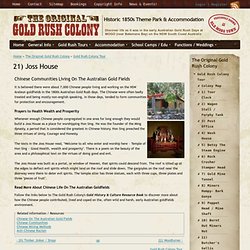
The Chinese were often badly treated and being mostly non-english speaking, in those days, tended to form communities for protection and encouragement. Prayers to Health Wealth and Prosperity Whenever enough Chinese people congregated in one area for long enough they would build a Joss House as a place for worshipping Hon Sing. Australian Gold, History & Culture Info - Historic Gold Rush Village Mogo South Coast NSW Australia. Western Australian gold rushes. Western Australian population growth between 1880 and 1897.[1] In the latter part of the nineteenth century, discoveries of gold at a number of locations in Western Australia caused large influxes of prospectors from overseas and interstate, and classic gold rushes.[2][3] Significant finds included: Halls Creek in 1885, found by Charles Hall and Jack Slattery.
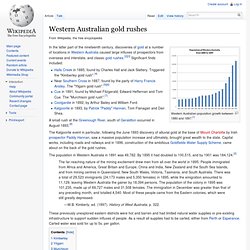
Victorian gold rush. Nerrena Fossickers in Nerrena Creek outside Ballarat Overview[edit]
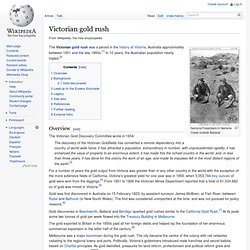
Chinese at the Australian Goldfields. Chinese at the Australian Goldfields At the time that news about the Australian goldrush reached China in 1853, the country had been suffering from years of war and famine.

In order to raise money for the fare to Australia, a man would take a loan from a local trader, agreeing to make regular repayments. His wife and children stayed behind, and worked for the trader if the man was unable to repay the money he had borrowed. To reach Melbourne, it was a journey of several months by ship in cramped conditions. A village in China. Australian gold rush. The 1850s gold rush attracted many Chinese people to Australia in search of a fortune.
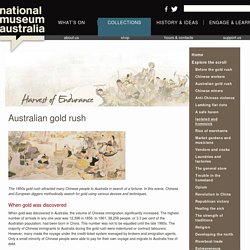
In this scene, Chinese and European diggers methodically search for gold using various devices and techniques. Goldrush Ballooning, Fleurieu Peninsula, South Australia. Gold Rush Motor Inn - - Queenstown - Tasmania 7467, Australia - Good old fashion hospitality where service counts. Find, mines, rewards, locations, South Australian Gold Rush. Australian 1850s Tours Accommodation Groups School Camps Weddings Funtions Venue. ~ GOLD ~ Australian gold rushes. Early Australian bushrangers. McFarlane & Erskine, Gold escort attacked by bushrangers, 187-, print: lithograph.

Image courtesy of the : nla.pic-an8420450. Australian Gold Rush. In fact they only got worse.

A powerfully disruptive hysteria seemed to grip the State along with the rest of the country. Farmhands simply left their employers with harvests they could no longer reap and thousands of workers fled Melbourne leaving empty industries in their wake. Wages tripled due to scarce labour. To raise money, many property owners put their houses on the market. But as there was no one interested in buying, house prices collapsed. Luckily however, this was not to last. Australia - The Gold Rush & The Eureka Stockade for Kids - FREE Presentations in PowerPoint format, Free Interactives and Games. The Australian gold rush. JCF Johnson, A Game of Euchre, col. wood engraving, Australasian Sketcher Supplement [Melbourne], 25 December, 1876.

Image courtesy of the : nla.pic-an8927787. The gold rushes of the nineteenth century and the lives of those who worked the goldfields - known as '' - are etched into our national . There is no doubt that the gold rushes had a huge effect on the Australian economy and our development as a nation. It is also true to say that those heady times had a profound impact on the national psyche. The camaraderie and '' that developed between diggers on the goldfields is still integral to how we - and others - perceive ourselves as Australians. Indeed, mateship and defiance of authority have been central to the way our history has been told.
Even today, nothing evokes more widespread national pride than groups of irreverent Aussie 'blokes' beating the English at cricket, or any other sport for that matter! The discovery that changed a nation. Gold Rush in Australia! The transportation of convicts to Australia was phased out between 1840 and 1868.
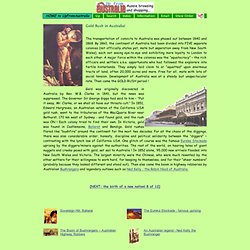
By 1860, the continent of Australia had been divided into FIVE separate colonies (not officially states yet, mate but seperation away from New South Wales), each not seeing eye-to-eye and exhibiting more loyalty to London to each other. A major force within the colonies was the “squatocracy” – the rich officers and settlers a.k.a. opportunists who had followed the explorers into fertile hinterlands. They simply laid claim to or “squatted” upon enormous tracts of land, often 20,000 acres and more. Free for all, mate with lots of social tension. Development of Australia was at a steady but unspectacular rate.
Gold! GoldRush.